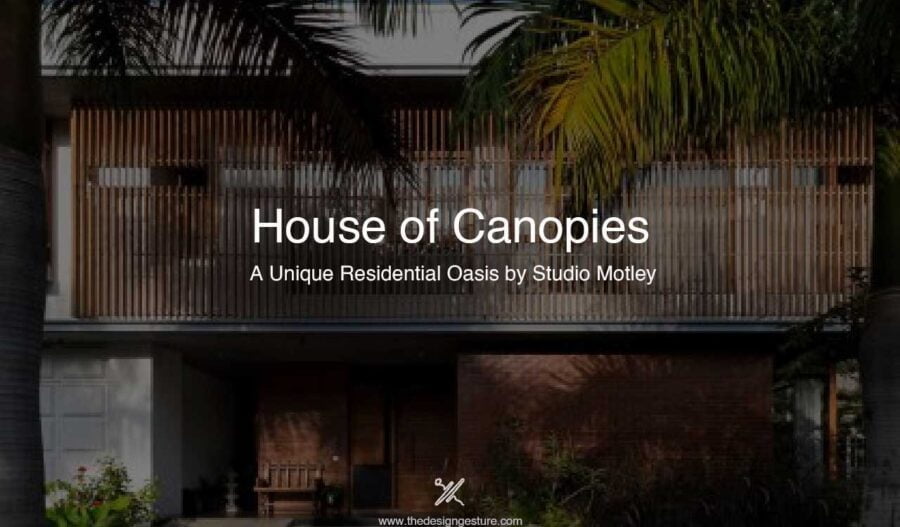Table of Contents
Project Brief
- Project Name: House of Canopies
- Practice: Studio Motley
- Completion year: 2022
- Gross Built-up Area: 8350 sq. ft.
- Project Location: Bangalore
- Country: India
- Lead Architect/Designer: Kajal Gupta
- Team: Anand Kurudi Rao, Kajal Gupta, Adhiti S. Gautama, Lakshmi Nair, and Dikshith T. George; Interns: Kumar Rohan, Pranal, Charu, Mahika, and Neha
- Clients: Deepak and Heena Vinchhi
- Structural Consultants: B. L. Manjunath
- The House of Canopies by Studio Motley, situated in Bangalore, India, is a distinctive architectural narrative that gracefully mixes modern architecture with an intuitive relationship to the environment.
Bringing Architecture and Nature Together
Studio Motley, recognized for its innovative and environmentally conscious designs, has developed another architectural marvel that blends seamlessly with its surroundings. The House of Canopies ingeniously includes outdoor living space as an integral component of the dwelling, resulting in a symbiotic connection between the structure and its environment.
The specification from the client was odd. While they intended to organize celebrations and extensive family reunions, they also intended to use it as a holiday weekend escape for the four of them to enjoy the outdoors, garden, and socialize.
As a result, there were to be no bedrooms at all, simply select recreational areas that opened up to one another and spilt out to the outside. On the first level, there is just one area with sliding folding doors, which might theoretically provide some solitude when needed.
Design ideologies
The House of Canopies features an unusual residence plan, with the main building located at the back of the property and a front courtyard substituting the standard entrance lawn.
The open areas are separated by a series of canopies, thus the suitable name. These canopies serve as linking elements, providing shade and creating one-of-a-kind exterior social areas that capture the spirit of ambient life.
The program is divided into two rectangular volumes, one holding the principal living rooms and the other the utility sections, which are divided by verandahs, entrances, and courts.
Drawing cues from conventional architecture processes, the structure strives to be reasonable while engaging all emotions by reacting to concerns of material, pricing, skilled labour, and, most crucially, climate.
The following approaches were used: The house was placed at the northern and lower extremities of the steep rolling land. Between the farms and the home is an open tank that catches rainwater runoff from the whole property and will be utilized for continuous intensive vegetation and landscaping.
The site’s natural slopes and drainage patterns were preserved, and any surplus rainfall is channelled from the open tank into a neighbouring bore well.
“The 1.5-acre property will be utilized for gardening, family activities, and as a personal weekend escape. The home has been proportioned appropriately, with the main living spaces having a small footprint but spacious verandahs that wrap around the house, allowing for bigger events. “The higher barrier zone encourages participation in and awareness of the environment,” Anand adds.
A Nod to Sustainability
The house is built with sustainability in mind. It makes use of locally produced materials, energy-efficient designs, and natural light optimization, demonstrating the architects’ commitment to environmentally conscious design principles. Besides being visually appealing, the canopies also serve a functional purpose by shielding the residence from the tropical heat.
The house’s longer extremities are oriented north and south to keep harmful direct sunlight out of the dwelling. Furthermore, all of the apertures are shaded to create a softer quality of light within the interiors.
A Seamless Transition
The House of Canopies is distinguished by the smooth transition between the inside and outside.
However, this characteristic is highlighted further by the use of large glass windows and doors that allow unobstructed views of the lush vegetation, creating a tranquil haven in the heart of the city.
The roof is an insulator in House of Canopies
The red cedar timber roof has three levels of sheeting. The ceiling is built of cement fibre sheets, with a centre layer of corrugated cement sheets and an outside layer of handcrafted regional tiles. It provides excellent insulation and decreases heat intrusion through the roof.
A continuous strip of ventilators supports the whole roof assembly, producing a precise link between the roof and the rest of the structure. A number of the panels within the continuous strip windows feature only an insect screen (no glass), allowing hot air to naturally ascend and exit the structure.
Natural and indigenous materials
The business used a naturalistic and indigenous material selection for the inside, including grey oxide flooring, locally quarried stone slabs for the verandah spaces, and brass for the fixtures and staircase railing.
The design stresses a simple and apparent structure while also allowing for flexibility and adaptation to usage. The structure, constructed by local craftspeople, aspires to a material and gesture economy.
Conclusion
The House of Canopies by Studio Motley is a monument to inventive design in a society where space is a luxury. It shows how architecture can transform a typical urban plot into a one-of-a-kind home hideaway, flawlessly merging the comfort of inner living with the quiet of outside regions. This incredible building shows the limitless possibilities that arise when builders work in harmony with nature.




